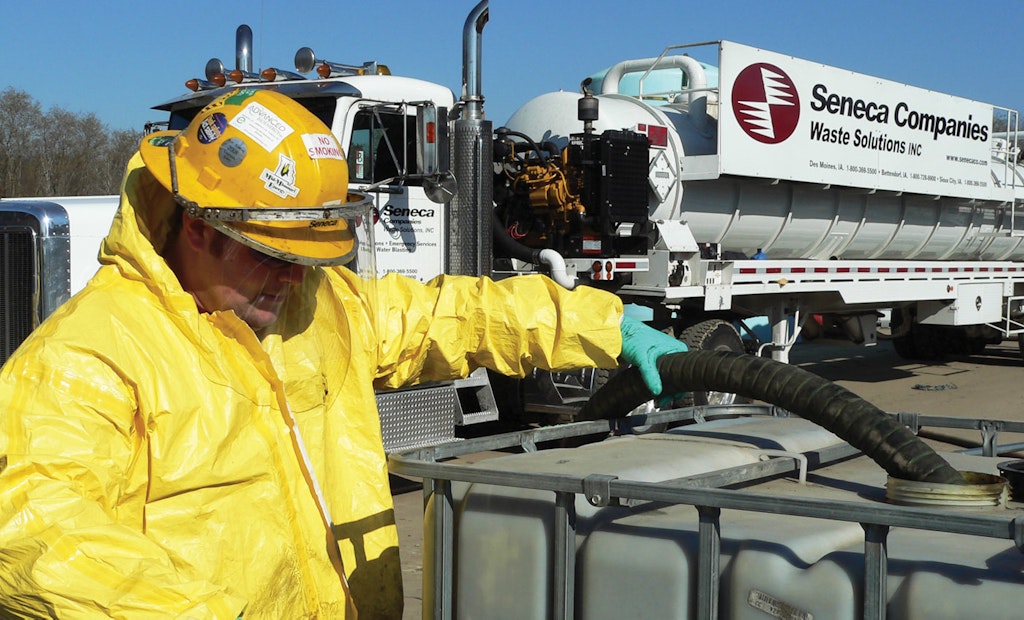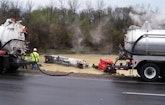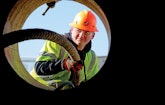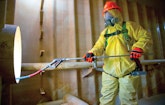
An employee removes liquid waste from totes at a U.S. EPA cleanup site for offsite transportation and disposal.
Interested in Business?
Get Business articles, news and videos right in your inbox! Sign up now.
Business + Get AlertsSeneca Waste Solutions is a complex, sprawling company. But the Des Moines-based business is built on a fairly simple business premise: Differentiate from competitors by providing customers with services they need.
“As a company, we don’t want to be like everybody else,” says Chris Biellier, vice president of environmental and strategic partnerships for Seneca Cos. — the parent company of Seneca Waste Solutions — and a 31-year veteran in the industrial-cleaning industry. “Our company is like a wagon wheel, and our customers are the center hub. The spokes represent all the services those customers need.
“We are constantly examining all of those spokes and thinking about what we can add to make it easier for customers in terms of service and technology — give them maximum results with minimal effort on their part,” he says. “Our motto is complete solutions. We want to surround customers with all the services they need to get their jobs done — take the headaches off their plates and manage them for them.”
To achieve that goal, Seneca Waste Solutions applies a large fleet of vacuum trucks and hydro blasters, 75 employees, more than half a dozen satellite facilities and a diverse array of services to provide for mostly industrial customers spread across 16 states.
On any given day, those jobs might include something as simple as pumping out water from a sump at a gas station convenience store or as complicated as responding to a pipeline or railroad car spill. Or perhaps performing scheduled maintenance work during a shutdown at an oil refinery or chemical-processing plant. Or hydroexcavating work, exposing pipelines and utility lines. Or cleaning out storage tanks, waste pits, tanks, grain elevators and the like.
“We’re kind of at the mercy of the telephone,” Biellier says. “We work with a lot of national emergency-response companies as their support — serving as the first boots on the ground.” To support such geographically diverse activities, the company operates support facilities in Des Moines and Davenport; South Sioux City, Nebraska; and Tulsa, Oklahoma; plus smaller satellite sites in Decatur, Illinois, and Nashville, Tennessee.
Moreover, to boost efficiency, employees such as vac truck and hydro-blaster operators are multitaskers, cross-trained and certified to perform many duties outside of just driving or operating their trucks and machines. For instance, depending on customer needs, a vac truck driver might also be certified for confined-space entry and emergency spill response work. They’re also cross-trained to operate different pieces of equipment and machines to ensure they can handle whatever situations might arise on job sites, Biellier says.
This strategy also helps the company better retain employees because they prize internal advancement and education. “They may come in as operators, but as they get trained and certified, they get to better themselves and better serve customers,” he says. “We like to give them ownership — empower them to solve problems and find better ways to do things.”
Moreover, employees enjoy the variety, which also reduces turnover. “Every day offers a different challenge. Plus, we actually get to see the rewards from the work we do."
Divide and conquer
The Waste Solutions division was formed in 2004 because customers of Seneca’s seven other divisions needed specialized industrial and environmental services. “They might be doing construction or site work, for example, and run into underground utilities or contamination,” Biellier explains. “Then they’d have to sub-subcontract the work to another company, which would create delays and angst for our customers.
“Or customers would come to us and say, ‘You guys do this kind of work, but we can’t find anyone to do that kind of work.’ So as the work continued to grow, we created a division that could stand on its own and go after more customers.”
Providing a wide array of services to so many customers requires a significant fleet of equipment. To that end, the division owns 20 wet-vacuum trucks: 15 made by Cusco, two from Presvac Systems, and two Dominators and one King Vac from Keith Huber. The trucks’ debris tanks range from 1,400 to 4,000 gallons. Two Cuscos and the King Vac units rely on liquid-ring vacuum-pump technology (1,100 and 3,500 cfm, respectively) and the other trucks feature vane vacuum pumps made by Moro USA (350 to 650 cfm).
The division also relies on eight wet-dry vacuum trucks: four made by Guzzler, three Supersucker units from Super Products and one King Vac from Keith Huber. The debris tanks range in size from 12 to 18 cubic yards. The Guzzlers and Supersuckers feature rotary blowers built by Howden (5,500 to 6,000 cfm), and the King Vac relies on liquid-ring technology (3,500 cfm) for vacuum power. All eight units also feature hydroexcavating packages.
The division also has invested in eight hydroblasting machines made by Jetstream of Houston with pressure ranging from 10,000 to 40,000 psi and flow of 18 to 86 gpm; and two more hydro blasters manufactured by NLB. The latter are mounted inside 14-foot Kenworth box trucks that feature 600-gallon water tanks and Jetstream of Houston pumps powered by John Deere engines (4,000 to 10,000 psi at 18 to 35 gpm). The operators use StoneAge nozzles.
In addition, the company owns five 5,000- and 6,000-gallon tanker trailers made by Heil Trailer International, Dragon Products, Keith Huber and Brenner (a brand owned by Wabash National); about 80 21,000-gallon frac tanks built by Dragon Products; and three automated tube-bundle cleaners built by StoneAge.
Smart investing
The frac tanks and the tube-bundle cleaners are good examples of the division’s strategy of not only providing customers with niche services, but also investing in new equipment and technology that leads to increased productivity, employee safety and customer service. Take the frac tanks, for example, which cost between $20,000 and $30,000 each, Biellier says.
Before, customers were frustrated because they’d rent the tanks from rental companies, which only did deliveries and pickups. “The big missing cog in the middle was handling disposal of the waste in the tanks. How can it be managed? And who provides offsite transportation and disposal? And when the frac tank no longer is needed, who can decontaminate it?
“We do all that,” he explains. “We basically added another service to an existing customer base. Our customers expect and demand that we look for more efficient ways to service them. If it was easy, they’d do it themselves. But it isn’t, so they look to us for for options.”
The company decided to invest in frac tanks because renting them was often problematic — not enough units were available or only available from a distant location, which increased the transportation costs. Having the tanks on hand gives the company better control and management of particular projects, and by spreading them throughout various service facilities, the tanks are closer to the customers that need them.
Moreover, owning so many tanks also positions the company to offer its services to new customers, too. “Frac tanks aren’t utilized by just a single industry,” Biellier says. “Any type of industry — construction, oil and gas, manufacturing, chemicals and so forth — that deals with process liquids need them. Anything we do is an investment, so we try to look for as many applications as possible for the same equipment.”
The investment in StoneAge automated tube-bundle cleaners also reflects the company’s commitment to better serving customers while at the same time providing employees with safer work conditions. Used to clean heat exchangers and other process piping in refineries and other plants, the machines enable workers to operate the machines from a safe distance from the high-pressure blasting zone.
“It’s physically demanding work, so if we can invest in tools that allow employees to work safer and with less fatigue, we do it,” Biellier says.
Looking ahead
Biellier anticipates further growth for the division. He envisions additional investments in tanker trailers, vacuum trucks, frac tanks, fuel-restoration services (restoring fuels contaminated by water or bacteria, for instance), and hydroblasting units. “As you grow, you have to be able to respond to customers’ needs and have available the equipment they need,” he says.
Biellier expects growth will continue via established customers as well as new ones. “We want to either add complementary services to existing markets or look for other markets where we can offer applications and services that aren’t used there,” he says. “But we want manageable growth. We still want to be able to react quickly to customer needs. The companies that will thrive are those that are willing to adapt to market needs, such as increased safety and efficiency. And we fully intend to be one of those companies.”
Empowered employees are the key component
Investing in advanced technology that amps up productivity and safety is a primary focus at Seneca Waste Solutions, based in Des Moines, Iowa. But the division of Seneca Cos. also invests heavily in something equally as important: It’s 75 or so employees.
“Companies that fail to invest in new technologies and equipment, as well as their people, eventually get left behind,” says Chris Biellier, vice president of environmental and strategic partnerships for Seneca Cos. “We have a desire to grow, and in order to grow, we have to be willing to invest in new technologies and people. You can’t have just one or the other — it has to be both.
“You can have three companies with the same equipment, but the people who operate them are the key component,” he adds.
At Seneca Waste Solutions, investing in employees means many things, including buying equipment that keeps them safer on job sites, listening to their needs, sharing information and empowering them to solve problems — and rewarding them for doing so.
As an example of the latter, Biellier points to an employee involved in a hydroexcavating project that involved slot trenching — under a very tight deadline — for installation of an underground irrigation system. The employee noticed the nozzle tips were using more water than necessary, which was slowing down the job.
“So he did an internet search and found a company (Hydra-Flex) that manufactures specialty pulse-and-rotate tips that direct the water in such a way that they cut soil more efficiently and create less spoil,” Biellier says. “These Switchblade and Ripsaw turbo nozzles cut about a third of the time off the job.”
The company also holds regular post-project meetings where employees critique jobs, pointing out what went well and what could be done differently next time to improve the results. “We allow that dialogue to occur very freely,” he says. “We’re very transparent with information; employees share any ideas they have. And we reward them financially for coming up with good ideas.”
About 10 years ago, Seneca Waste Solutions took a hard look at the causes of employee turnover, and the aha! moments gleaned from that study inform many of the division’s employee-management philosophies and practices. For example, the division now rotates the crews who are on call during weekends and holidays, since schedule unpredictability was revealed as a sore point. And it compensates those on-call employees whether they’re called in to work or not, Biellier says.
“Every company has turnover, but we have less than we did 10 years ago. We learned how to run our business by being observant of the conditions under which our employees work. Sometimes pay is the issue. For others, it’s available free time, modern equipment and how managers talk to people and engage them.”
Different branches of the division deal with different issues because of the work they do and the customers they serve. As such, the division developed strategies and initiatives specifically designed to address those varying issues and employee groups.
But in the end, it all boils down to creating environments where employees can feel free to openly communicate and engage in constructive dialogue, as well as using different communication styles and methods for different groups of employees.
“The hardest thing about managing people is managing people,” Biellier says. “If you have a message to deliver to 12 people, you have to be willing to deliver it 12 different ways if necessary so they all understand. A lot of employees in our division come from construction, farming and military backgrounds, so they’re all wired differently. We need to accommodate those differences."










